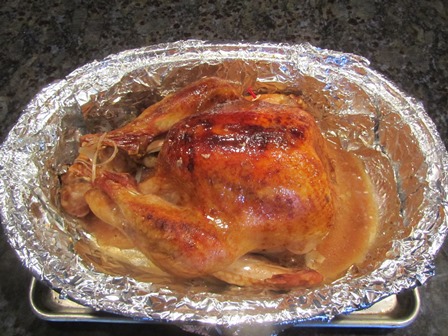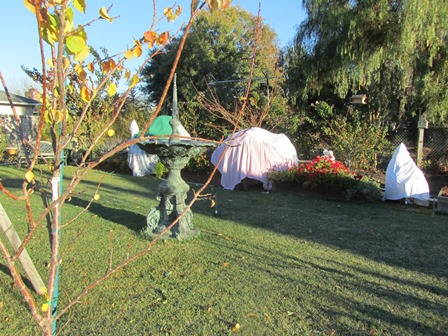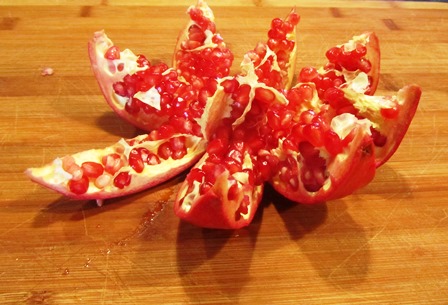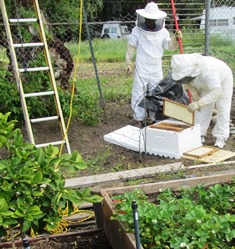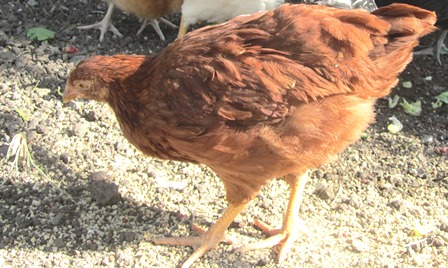Blog Archives
Happy Thanksgiving!
Up at seven o’clock today meant I caught the sunrise while letting the chickens out of the hen house to forage around the farmette in frigid temperatures.
I got a good head start on prepping the turkey today. I popped it into the oven by 7:30 a.m. before starting the other side dishes like cornbread stuffing, butternut squash with cranberries and cinnamon-spiced nuts, and the other vegetable and appetizers.
The pumpkin pie is made. I only have to make homemade whipped cream for a dollop on top. Last night, I whipped out two versions of cranberry relish–the traditional stove-top relish and the other made with fresh cranberries.
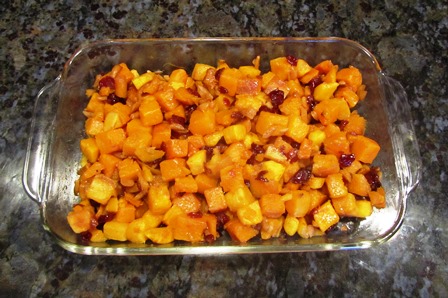
Cubes of butternut squash with dried cranberries and cinnamon-spiced almonds and just a hint of honey for a little sweetness
The fresh cranberry relish was exceedingly easy to make–two small pippin apples and an orange right from my backyard tree, plus three cups of freshly washed cranberries. I washed the apple and orange, cored the apple and removed the seeds from the orange. Then I just pulsed everything together in a food processor, poured it all into a glass jar and put it in the fridge.
So all the food goes into the car around lunchtime. We’ll serve it at my daughter’s home where the rest of our family will gather together to give thanks for our blessings. We’ll pray for those far from home and those without a home and the less fortunate on our planet.
Some have ordered my novel, A BEELINE TO MURDER, for me to sign. I’ll give them jars of lavender honey as a thank you.
God bless you, my readers. Happy Thanksgiving.
For more tips on farming and beekeeping, plus delicious recipes, check out my newest mystery–A BEELINE TO MURDER. See, http://tinyurl.com/p8d6owd
Blankets for Trees & Bees on Frosty Nights
I don’t like to take chances with my citrus trees when overnight temperatures drop to near freezing. I cover them with sheets and blankets.
My hives are in a wooden shelter with a tin roof and the back side open, so I can work without any encumbrance. But I don’t want the bees to have to work harder to keep the hive warm for the queen and babies, so I throw some blankets over my beehives, too.
Also, on particularly cold nights, I hang a warming lamp in my chicken house. My rule of thumb for my hens is when overnight temperatures are expected to drop below 45 degrees, I turn on the lamp so the hens aren’t stressed.
An advantage of hanging a heat lamp in the chicken house is to foster egg laying at time when shorter days of light slows egg production. The heat lamp makes light available to the chickens for a much longer period.
De-Seeding a Pomegranate
Pomegranates are known since biblical times as a food of the gods. When ripe, the fruit’s leathery skin often splits open, exposing the red seeds inside. The fruit hangs like a jewel from a strong stem that must be cut or twisted to release the fruit.
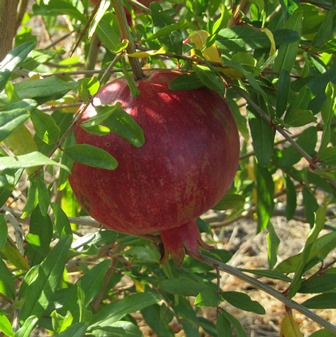
Ripe pomegranates have a leathery outer skin, membranes thicker than oranges, but sweet, juicy seeds inside
Inside a ripe pomegranate are hundreds of juicy, sweet seeds that resemble small pegs of sweet corn. Holding the seeds in place are membranes.
The ruby red juice will stain fabrics and your fingers, so you’ll want to be careful handling the fruit as you release the seeds. The juice will stain your cutting board, too, but that stain can be removed with a lemon juice or vinegar scrub.
Cut off the stem and the blossom end.
Make a long shallow cut from the top to the bottom and up the other side, but avoid cutting deeply to avoid damaging the seeds. Then rotate the fruit and make a second cut completely around. Make 6 or 8 such shallow cuts to create equal sections.
Pry open the fruit to expose the seeds (known as arils). Place the fruit into a basin of water for 5 minutes. Working over the basin, peel the skin off and strip away the membrane pieces to release all the seeds.
Pluck out the membranes and rinse the seeds in a strainer. They are ready to be tossed into salads, eaten fresh, or stored in an airtight container (not metal) for 3-4 days. The seeds may also be made into juice; however, straining the juice from the seed pulp will be necessary.
If you keep chickens, it might interest you to know they love fresh pomegranate seeds. Seeing a ripened fruit with its peel split open and seeds exposed is a temptation for them to peck at low-hanging fruit on the tree.
Finding Time for Everything
Anyone who keeps bees and chickens, maintains an orchard, and grows their own food will tell you that the work never stops. There’s always something to do. For me, the challenge is finding time now to clean and waterproof sheds, do the fall cleanup, feed my bees, clean the chicken house, pull out the tomato vines, and well, you get the idea.
For me, the past week and the coming week have been so packed with deadlines and fulfilling contractual obligations to my publisher and promotional outlets, that I’ve found very little time available to do anything but keep my promises. But I don’t mind. I am loving the journey of getting my first of three cozy mysteries launched.
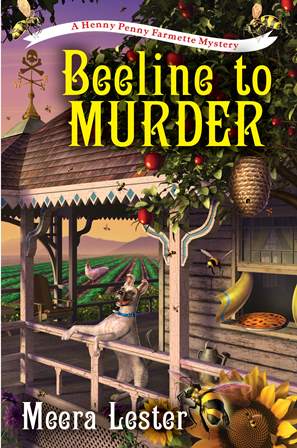
The first novel in my cozy mysteries is set on my Henny Penny Farmette and is available through Amazon, Barnes & Noble, and bookstores everywhere
Today, I’m taking two hours to empty out the six-by-six foot garden shed. So far, I’ve found a dead rat and two dead mice amid all the garden items, tools, and building materials in that shed.
A small rainstorm blew through last night and caught me unprepared. I’d left boxes outside and had to leap from bed and dash out into the pelting rain to get items indoors. Then, just as I finally put my head against my pillow and listened the wind howling through the eucalyptus trees out back, a skunk crossed under my open bedroom window.
You guessed it. That foul-smelling skunk spray really put the kibosh on drifting off to dreamland. But once I fell asleep, it was deep and restful–so important to a creative mind. But as soon as my feet hit the floor this morning, I harbored hope to have more energy today than yesterday and more time. I’m guessing you know what I mean.
Check out the reviews for A Beeline to Murder at: http://www.amazon.com/Beeline-Murder-Henny-Farmette-Mystery/dp/161773909X/ref=sr_1_1?s=books&ie=UTF8&qid=1443997291&sr=1-1&keywords=Meera+Lester
Protecting Your Backyard Flock in a Heat Wave
I lost a chicken this morning despite taking measures to protect her from the deadly heat wave we’ve been having here in the Bay Area. The last thing someone attached to their hens ever wants to see is one of her precious little girls gone. Mine was a Silver Laced Wyandotte (who leaves behind a sister) and five other hens with whom she was raised.
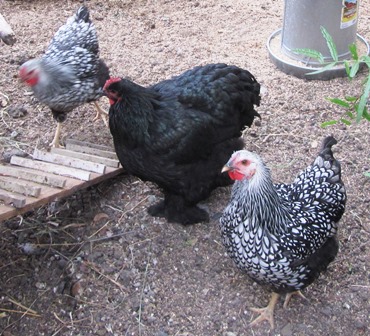
The Silver Laced Wyandotte (black-and-white) hen in the foreground succumbed to the extreme heat sometime during the night
Our farmette sits in the east bay hills and too far inland from the San Francisco Bay or the delta (which flows to Sacramento) to gain much benefit from cooling breezes off the ocean. We’ve had triple digit temps on the farmette for days.
I put out extra water basins for my chickens, kept their doors open in the chicken house at night (there is a wire run with a wire ceiling to protect them when they’d rather roost outside), and fed them frozen corn, cool seedless watermelon treats, and chilled grapes.
The chicken house has windows that I keep open (they have reinforced wire over the screens). I reduced the amount of litter on the floor (I use ground corn cob) since it could hold the heat.
I haven’t install a fogging system or fans, but I might if this heat keeps up.
The only telltale sign that my hen was in trouble was that she seemed to exhibit lethargy and to have lost weight (although it was difficult to tell under all her feathers).
Her comb had turned slightly pale and seemed to have shrunk in the last 24 hours. When I check on her last night she was turning herself to face the wall. Not a good sign since, in my experience, I’ve seen chickens do this before they pass away.
Some strategies for helping backyard chickens survive extreme heat include the following tips.
Eight Strategies to Help Chickens Beat the Heat
1. Make sure windows of chicken houses face north to south to allow breezes to blow through, rather than face east to west (rising and setting sun).
2. Keep litter on the chicken house floor low (1 to 2 inches is sufficient).
3. Position your chicken house under a tree, if possible, where the structure receives shade.
4. Make certain you have several watering dispensers (placed in the shade) with clean, fresh water every day during hot weather.
5. Add ice cubes to the watering canisters.
6. Put out treats such as bowls of frozen corn and cool, seedless watermelon, and chilled grapes or blueberries.
7. Use a fan, if necessary to remove heat from the chicken house.
8. As an emergency measure for a chicken that looks distressed, dip her in cool water.
Update on the Buffo Broodzilla
My Buff Orpington hen, who’d been sitting on a couple dozen infertile eggs for weeks–some rotten and others broken–finally left the nesting box after I removed all the eggs. I’ll be set up for baby chicks next year in my hen house, but not now.
At first, she continued to display her broodzilla behaviors (aggressive, flighty, angry) and was easily set off by the antics of the other chickens. However, within a day or two, she’d normalized her old laying routine and began running with the other hens as they foraged around the farmette, took dust baths, clamored for chicken snacks, and pecked at each other.
My neighbor told me to dunk her in cold water to break her broody cycle. That’s because hens who go broody have an elevated body temp. Removing the eggs worked this time; maybe next time, I’ll try cooling her off. Or . . . if it happens in the spring, I might get some baby chicks and let her raise them.
I’m certain there will be a next time–she’s gone broody three times in a year and half. Some hens have that tendency.
Rain, Russian Poetry, Rugelach, and Longfellow
It’s been raining for hours. It’s the kind of day I love to listen to classical music, read Russian poetry, and dine on tea and apricot/walnut rugelach. The rugelach recipe is not mine, but I did use my Henny Penny Farmette apricot jam in the making of it. For the recipe, see, http://www.foodnetwork.com/recipes/ina-garten/rugelach-recipe.html
I could be doing a lot of other things like writing on my novel (but I’ve already put in four hours today on that, having arisen at 4:00 a.m., so a break is in order). I could be doing laundry, mopping the floors, decorating the house for the holidays, or changing the bedding. But I’m not.
I’ve missed the rain that brings the smell of decay and greens the moss.
California has been in a terrible drought for three long years. We’re going to get a week of wet stuff, say our weather forecasters. I want to enjoy these blessed, wet moments.
I let the chickens out of the hen house to forage, but they’ve remained in a huddle beneath it. A cold, unstable air mass will bring thunderstorms this afternoon. I doubt the chickens will even leave the run today, but that’s okay, too.
It’s a perfect day for me to stay inside. Maybe I’ll make bread. There’s enough time still for two risings. I’ll form it into a braid and bake it for dinner. Perhaps I’ll make a hearty soup–one from Brother Victor-Antoine d’Avila-Latourrette’s Twelve Months of Monastery Soup book. A citrus salad would be the perfect accompaniment.
What was it Henry Wadsworth Longfellow said about rain, “The best thing one can do when it’s raining is to let it rain.”
How My Real Life Informs My Art
Every story needs a setting, a world in which something happens. For my cozy mysteries, I didn’t set out to create a new world for my coterie of characters, I just appropriated details of the life I am living as a farmette dweller.
Daily chores on our Henny Penny Farmette provide plenty of fodder for my fictional stories. Our daily activities include chicken care, garden and orchard work, beekeeping, cooking and preservation of vegetables and fruits, renovating the antiquated farm house, fixing sheds, and building fences and retaining walls.
Stories need a sense of verisimilitude for readers to suspend disbelief and join the fictional journey. Drawing upon my real-life experiences, I can easily integrate my adventures in my books. And not only my activities, but also experiences of my architect husband who is ever-occupied with making our old house more liveable.
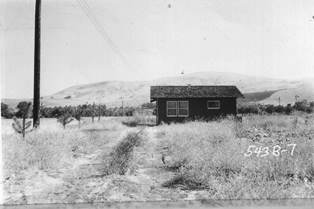
In this 1953 photo, our little house sat in a great, big field with not much around it; the dwelling faced Mount Diablo (still does) and the Delta and great central valley lie to the northeast
The tax assessor told me that our dwelling might have been a mining shack in the late 1940s (we live near Mt. Diablo and Lime Ridge where mining and rock quarrying were once important industries). We’ve also been told that our little house might have later served as a farm home (we live less than two miles from designated agricultural farmland). The structure desperately needed updating when we found it almost five years ago. But as settings go, the house and farmette work great.
We have since used recycled and reclaimed materials, sale items at big box DIY stores, and gifts (like lumber, stone, and windows/doors) from friends who do demolition on estates. We’ve visited companies that sell granite and asked for permission to take broken stone from their dumpsters. Thus, we’ve created a lovely bathroom floor with found materials that we’ve cut and sanded.

Light from a crystal chandelier dances off the new granite counter, but the floors were not yet installed when this photo was taken
Of course, the exact details of our daily activities may not make their way into my stories, but versions of them sometimes do. At the very least, such activities inform my storytelling. I daresay the chickens and bees serve important roles in my mysteries. And each new day brings new adventures, from foxes showing up to skunks and raccoons raiding our fruit and nut trees.
Lately, a new chicken showed up on our property (a heritage chicken that had the ability to fly over my neighbor’s fence). She’s been staying here ever since. Wild turkeys often take a path through the property and once or twice a gorgeous stallion named Romeo and its owner ride by and say hello. Such events can add textural details to the setting of a story.
Try Having a Cup of Tea with These Dogs
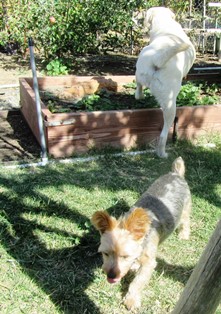
Remington, the white, short-haired lab, is trouncing over the strawberries, while Moose has his sights set on the chickens
I just wanted a nice cup of tea and to sit on the grass and sip it while listening to the birds and watching my bees and chickens. Fat chance. It would take five minutes flat for my daughter’s little dog Moose to knock over the cup, spill the tea all over me, and then traumatize my chickens so badly that their egg-laying is now out of wack; they’re just squatting and dropping.
As a favor to my lovely daughter and her family, I agreed to dog sit on my farmette for four days. My daughter assured me the two family pets would enjoy four days of freedom to romp around our acreage despite one of her dogs being a little high strung. His breed used to chase rats, she said. I didn’t make the correlation. It didn’t seem to matter then.
I reminded her that my bees and chickens both forage freely over the land. The chickens would necessarily have to remain in their chicken run during that period since the dogs might chase them. The bees probably wouldn’t bother the dogs, but I’d take the name of her vet, just in case. Of course, the dogs might not actually like it here.
In retrospect, I believe I underestimated my concerns. Oh, the dogs seem happy enough; it’s my sanity I’m worried about.
The Irish lab named Remington has had some professional training. He is a lovely, well-behaved gentleman. I enjoy him and wish I could same the same for the small dog with the mighty name of Moose who is high-strung, has allergies, and arrived with special gluten-free food, his round bed, and a bag of medications, including a vet-prescribed tranquilizer.
Moose barks a lot. It’s an annoying high-pitched bark. In the yard yesterday, when he wouldn’t stop, I heard my neighbor barking back . . . and that’s just ridiculous!
I thought Moose was going to have a meltdown when he discovered the chickens, barking at the highest decibel he could muster, running the length of the chicken run in one direction with the chickens one step ahead on the inside their poultry-wire pen before hitting the wall where the dog and chickens reversed their direction.
I got half as many eggs yesterday and found two on the ground instead of in the nesting boxes. When the chickens free-range, they always return to the nesting boxes in the hen house to lay their eggs. It’s like they got so scared, they forgot not only where to go but how to properly lay their eggs. I hope things return to normal when the dog visit is over.
I decided to spend the day outside, doing chores like digging planting holes at the front of the property. Moose saw it as a game so as soon as my back was turned, he refilled the holes, pawing like a dog on a mission. I finally gave up on that. The shovel and rake seemed to scare him, so I put those away. And he didn’t like me playing ball with him or the other dog. So we quit on that, too.
By the day’s end though, both dogs seemed tuckered out. Both wanted to sleep in our room. The big dog contented himself in his bed on the floor (by my husband’s side of the bed), but the high-maintenance Moose threw himself onto my pillow, pulled my fleece bathrobe over his head, and nodded off like he owned the place.
When our alarm went off at four o’clock as it does every weekday morning, the yip-yip-yipping and chaos started all over again. Only three more long days and nights left.

Remi wasn’t the problem but with Moose frightening the chicken feathers off my hens, I draped the chicken run in sheets
I’m going to need a vacation when these four days are over. I just hope my chickens will resume their egg-laying schedule once I take the sheets down off the chicken run (I hung them so Moose couldn’t see the chickens) and I have the energy and some decent weather ahead to re-dig those planting holes. I look forward to having a cup of tea again, too, while I listen to the birds and quiet clucks instead of that shrill yip-yip-yip, amplified by by neighbor’s imitation of it. Ridiculous!
Help–There’s a Chicken on My Back
Collecting eggs, I bent over into the chicken house. Suddenly, a large chicken land on my back and start talking to me in her chicken language. I immediately knew it was my Rhode Island Red. She follows me everywhere.
It would have made a cute picture, but here’s the thing: you don’t want chickens tarrying too long in one place because they are famous for frequent and abundant droppings.
The Rhody is the most personable chicken in my flock and the one I handled the least when I cared for the flock of baby chicks in a tub in my kitchen. However, the chicken I handled the most from my tub of baby chicks was the yellow Buff Orpington, and today she’s difficult with the other hens and its also the first to have gone broody.
As I do chores around the farmette, the Rhody keeps me company. When I go inside to work in my office on my writing projects, she often hangs out under my office window, clucking or making an number of various chicken sounds. She also responds to my voice when I call out her. If I had it to do over again, I’d have a whole flock of Rhode Island Reds, just for the personality.
 Facebook
Facebook Goodreads
Goodreads LinkedIn
LinkedIn Meera Lester
Meera Lester Twitter
Twitter




